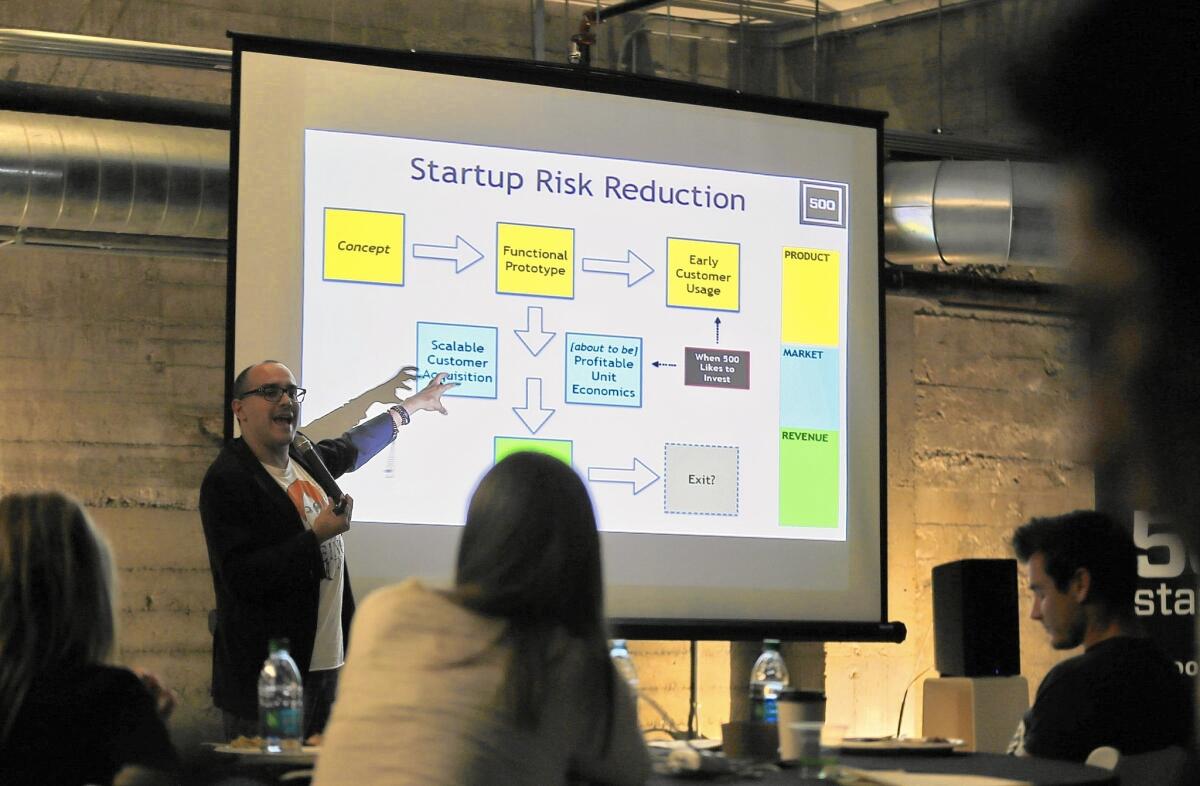At Silicon Valley Bank, risky tech start-ups are lucrative business

Few banks are as close to the industries they serve as Silicon Valley Bank is to the technology world.
An industry mainstay since the 1980s, the bank veers far from the course of conventional financial institutions.
Part lender, part consultant, part cheerleader and part investor, Silicon Valley Bank has been a nursemaid to countless start-ups — Airbnb, Fitbit, Pinterest and TrueCar, to name some recent ones — as well as banking the venture capitalists who fund them.
By many measures, the bank has outperformed bigger rivals, not just by lending to fledgling firms but by taking small ownership stakes in them to help offset their higher risks.
------------
FOR THE RECORD:
Silicon Valley Bank: An article in the Aug. 8 Business section about Silicon Valley Bank referred to James Slavet as a venture capital investor at Greycroft Partners. His firm is Greylock Partners. —
------------
RBC Capital Markets analyst Joseph Morford, a fan who has followed the company for 23 years, said clients once would jump to bigger banks as they grew. At $40.2 billion in assets, Silicon Valley Bank now has the heft to handle them from start-up to initial public offering, multiplying its profits on larger loans and fees.
These days the bank is following the venture capital trail abroad, with 8% of its loans overseas and 18% of deposits from other countries.
Deposits and other funds managed for clients are up 77% in the last two years, reflecting venture investments and stock-sale proceeds that are flooding the coffers of software, hardware and healthcare companies. Loans and other assets are up 81% since 2013.
Even after a recent sell-off, stock in the bank’s parent company, SVB Financial Group Inc., has risen 55% in the same period — far surpassing the gains of giants like JPMorgan Chase & Co., Citigroup Inc., Bank of America Corp. and Wells Fargo & Co. The shares have shot higher than shares of regional competitors as well, with a more than twofold gain over the KBW Regional Bank index.
Other banks, including City National Corp. and Comerica Inc., have made plays for tech clients “but have not had even a small percentage of the success,” said analyst Gary P. Tenner at D.A. Davidson & Co.
“It’s not just a question of being there” as the industry takes off, Tenner said. “It’s the relationships Silicon Valley Bank has developed over the years and, frankly, their reputation. I think they probably get the first look at a lot of deals.”
The bank, which recently opened an office in Santa Monica, is more willing than others to focus on a start-up’s growth prospects rather than its current financial condition and to lend money so businesses can expand while awaiting the next round of venture capital funding, said investor Mark Suster, a client and managing partner at Upfront Ventures in Los Angeles.
At Cornerstone OnDemand Inc. in Santa Monica, for instance, the bank “created a new type of financing for us that they now use with cloud-based companies around the country,” said Adam Miller, chief executive of the employee-management services company.
It’s common for lenders to provide receivables financing, which uses money owed to a business as collateral for loans. But even before Cornerstone went public in 2011, Silicon Valley Bank took a riskier step — making loans secured by expected revenue from contracts for services the company had not yet delivered, Miller said.
“Because they start so early, they are willing to kiss a lot of frogs; they meet a lot of companies that don’t get very far,” Miller said. “But that willingness to work with riskier clients puts them in an advantageous position later on” as companies grow and require more banking services.
Silicon Valley Bank often requires founders to hand over small ownership stakes in return for more favorable credit terms. Profits on equity warrants — options to acquire stock cheaply — can yield big profits when companies go public.
The bank, for instance, recorded a $23.6-million gain on warrants in the second quarter, including $13.9 million related to the initial public offering of FitBit Inc., the maker of fitness-tracking wristbands. Gains on the tactic have exceeded losses on early-stage loans over the last 10 years, the bank said.
The bank is aggressive in courting investors as well, part of why it has become the “first call” bank for many of them, said James Slavet, a Menlo Park, Calif., venture investor with Greylock Partners.
“When I joined Greylock nine years ago, a top guy at the bank immediately reached out and said, ‘Hey, it would be great to meet up and see if there’s any way I can be helpful.’ I didn’t get that reach-out from other institutions,” he said.
The bank, which opened in San Jose in 1983, now is based in a cluster of low-rise Santa Clara offices where an in-house TV studio connects executives to the bank’s offices in 27 U.S. technology centers and in London, Beijing, Shanghai and Herzliya Pituach, a wealthy Israeli enclave on the waterfront near Tel Aviv.
As a leader in serving software, hardware, biotech and healthcare start-ups, with a side niche in lending to premium wineries, the bank has served Southern California from offices in Sherman Oaks and Irvine.
It tapped into shifting trends in May by opening the Santa Monica office to focus on the tech boom along the coast, where online dating service EHarmony Inc. was born and video messaging firm Snapchat Inc. is growing up. Google Inc. and Yahoo Inc. are setting up Southland hubs in nearby Playa Vista, close to a Facebook Inc. facility.
Los Angeles also is where the venture capital money is flowing, turning it into a major center nationwide for venture-backed start-ups, said bank Chief Executive Gregory W. Becker.
“Innovation is booming there right now,” Becker said. “The energy and growth we’re seeing in the Santa Monica area reached an inflection point, so it made sense to add another location.”
Given the cyclical nature of the tech industry, one question is how well Silicon Valley Bank can manage the next downturn.
After the dot-com bust in 2000 and the financial crisis in 2008, its shares fell more than 70%. That history weighed on the minds of investors after the stock hit a 52-week high of $150.63 on July 20 and quarterly earnings were released three days later.
Though its net income rose 69% to $86.1 million, beating analysts’ estimates, it said two large loans went sour and helped push an index of credit troubles to the highest level since 2010. Expenses rose, and executives acknowledged that recent outsized gains on stock warrants would probably not continue.
The shares plunged, closing Monday at $137.90, as the sharp drop in Chinese stock prices undermined the prospects for Silicon Valley Bank’s expansion plans there.
Executives at the bank have warned recently that tech investments may be overheating, though not to the degree seen during the dot-com craze. They said Silicon Valley Bank, while enjoying a reputation for being highly competitive on loan rates and terms, has been ceding some deals to new entries in the field.
“The market has become more competitive, and with greater frequency we have elected not to compete to win business that we thought was too highly leveraged or too loosely structured,” Marc C. Cadieux, the bank’s chief credit officer, told analysts on last week’s earnings call.
The bank certainly has competitors, and analyst Michael Pachter at Wedbush Securities in Los Angeles thinks plenty of other banks are capable of meeting the needs of growing companies for loans to finance expansion. But most do tech lending as only a side business or will lend only to companies that have grown well beyond the high-risk early stages.
Most also don’t come close to Silicon Valley Bank’s well-connected network of outside experts, mentors, tech executives, venture capitalists and current and former clients ready to help its upstart entrepreneurs — no matter how farfetched an idea might seem.
Becker has heard them all. The chief executive raised his eyebrows over one plan from Travis Kalanick, a UCLA dropout from Northridge. Kalanick already had built and sold Red Swoosh, which enabled users to swap music and videos over the Internet, when he started gushing about a global plan to connect passengers with drivers willing to hire out or share their vehicles.
“He was penciling out this plan for world domination,” Becker said. “You sit there and say to yourself: ‘This is frickin’ insane. How are you going to do this?’”
Still, Kalanick became a client, and his vision was made real as Uber Technologies Inc., which is valued at $50 billion, based on the latest round of venture capital it is raising.
ALSO:
Solid job growth in July paves the way for a Fed interest rate hike
Personal finance Q&A: How much of IRA contribution is tax deductible?
Long Beach high-rise sells at $45-million discount despite ‘mesmerizing’ view
More to Read
Inside the business of entertainment
The Wide Shot brings you news, analysis and insights on everything from streaming wars to production — and what it all means for the future.
You may occasionally receive promotional content from the Los Angeles Times.











